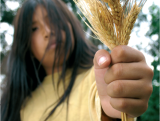FAO publishes a new resource guide on good nutrition in crisis and recovery
27 June 2005, Rome - Enabling people in emergencies to realize their right to food and ensure the nutritional well-being of their families should be an important objective of relief and rehabilitation efforts, FAO said today.
Violation of the right to food, as often occurs in situations of conflict and crisis, can seriously offend human dignity. It can also lead to increased vulnerability to illness and malnutrition FAO said in a new publication entitled 'Protecting and promoting good nutrition in crisis and recovery'.
Every year, floods, droughts, earthquakes, outbreaks of plant and animal pests and diseases and other natural disasters as well as armed conflicts, adversely affect the lives of millions of people in the developing world. Access to a nutritionally adequate amount and variety of good quality and safe food becomes difficult and contributes to high rates of malnutrition.
When a crisis occurs, food production is often no longer possible, income is reduced, food distribution and marketing networks collapse, and people's homes and belongings are looted, destroyed or burned. The disruption of normal life results in rising poverty and vulnerability to food insecurity and malnutrition.
Improved nutrition and protection of livelihoods
"Temporary food distribution is necessary to help people to cope under emergency conditions. However, at the same time, assistance is also often needed to help restore local food production and to reduce the dependency on food aid," said Anne M. Bauer, Director of FAO's Emergency and Rehabilitation Division.
The new FAO resource guide - available in print and as a CD-Rom - offers guidance to programme planners and technicians in the field of nutrition, food security, agriculture, and community and social development on how to adopt a long-term perspective to food insecurity and malnutrition during periods of crisis and recovery.
Whenever possible, the publication states, food distribution should be combined with actions to improve self-reliant access to food. If there are suitable conditions for agriculture and livestock husbandry, diversified food production which reflects seasonal food shortfalls and nutrient gaps should be supported.
"Food diversity can be increased through field crop production, horticulture, rearing of poultry or small livestock, cultivation of fruit and nut trees, fishing, small-scale irrigation and the utilization of wild foods," said Kraisid Tontisirin, Director of FAO's Food and Nutrition Division.
Nutrition education
Food and nutrition education plays a vital role in protecting and promoting household food security and nutrition. For example, nutrition advice on eating certain foods should be supported by advice on how to plant, protect, store, process and prepare those foods.
"Adequate knowledge of what constitutes an appropriate diet, as well as the skills and motivation to practice good care and feeding practices, are vital for households' survival, during times of crisis," said Tontisirin.
